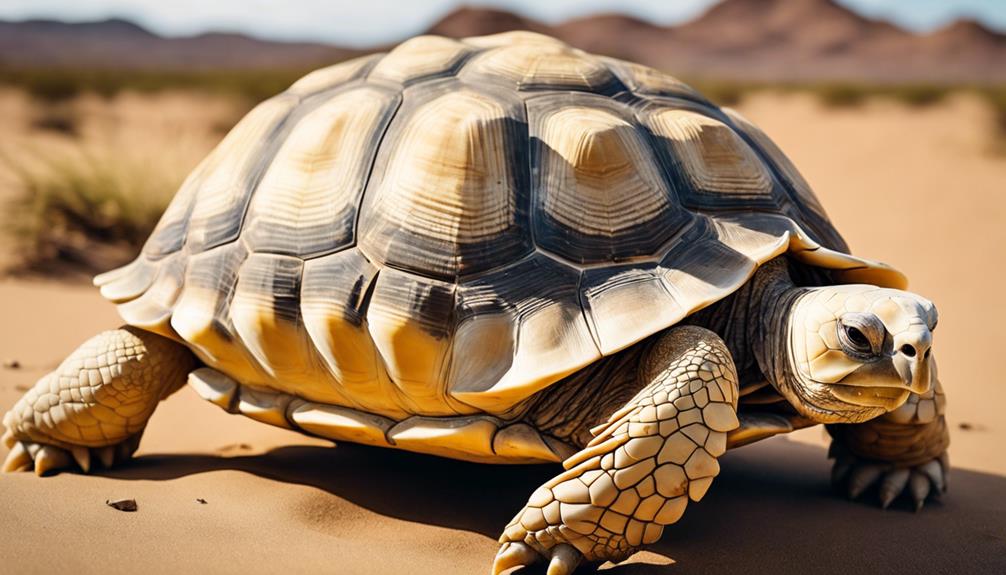Curious about how a Russian Tortoise Age Size Chart can demystify the growth journey of these intriguing creatures?
From the factors that influence their size to the milestones they reach at different ages, this comprehensive guide offers insights into the world of Russian tortoise development.
Understanding these nuances not only sheds light on their growth patterns but also plays a crucial role in their care and well-being.
Ready to explore the intricate details that shape the size and maturity of Russian tortoises?
Key Takeaways
- Russian tortoises reach 8-10 inches in adulthood after 15-20 years.
- Females are slightly larger than males, with females reaching 6-10 inches.
- Proper nutrition and care support growth to exceed 40 years.
- Monitoring size aids in determining gender and predicting eventual size.
Average Russian Tortoise Growth Rates
On average, Russian tortoises exhibit a steady growth rate, gradually reaching a size of 8-10 inches as adults. Female Russian tortoises generally tend to be slightly larger in size compared to their male counterparts. When they first hatch, these tortoises typically measure around 1.5-2 inches in length. It takes approximately 10 years for Russian tortoises to reach sexual maturity. Throughout their lifespan, with proper care and living conditions, these tortoises can live for over 40 years, taking about 15-20 years to attain their full size.
The size difference between male and female Russian tortoises is noticeable, with females having a slightly larger average size. Hatchlings start small but over time, with healthy growth and suitable living conditions, they gradually reach their adult size. It's essential to provide the appropriate environment and diet for optimal growth and development to ensure that Russian tortoises reach their average size range of 8-10 inches.
Factors Influencing Russian Tortoise Size
Factors influencing the size of Russian tortoises include genetics, gender differences, and various environmental conditions that impact their growth and development. Several key factors play a role in determining the size of these tortoises:
- Hibernation Duration: The length of hibernation can affect the growth rate and final size of Russian tortoises.
- Diet Impact: Access to a quality herbivore diet is crucial for proper growth and development.
- UVB Light Exposure: Adequate exposure to UVB light is essential for calcium absorption and overall health, influencing tortoise size.
- Genetics Influence: Genetic factors can predetermine the potential size a Russian tortoise can reach, impacting growth throughout its life.
These elements, combined with captivity conditions and other environmental factors, contribute significantly to the ultimate size of Russian tortoises. Understanding and managing these factors can help ensure the healthy growth and development of these unique reptiles.
Gender Differences in Russian Tortoises
Exploring the Size Disparity Between Male and Female Russian Tortoises offers valuable insights into the unique physiological differences influencing their growth patterns.
In general, female Russian tortoises tend to be larger than their male counterparts, with adult females reaching a length of 6-10 inches, while males typically grow to be 5-8 inches long. This size difference is primarily attributed to the need for more space during pregnancy for female tortoises.
Monitoring the size and growth of a tortoise can aid in determining its gender based on typical size ranges. Gender differences in Russian tortoises play a significant role in predicting their eventual size due to the variations in size between males and females.
Importance of Proper Nutrition
Understanding the dietary needs of Russian tortoises is crucial for ensuring their growth and overall well-being. When it comes to the diet of your pet Russian tortoise, here are some key points to keep in mind:
- Balanced Diet: Providing a balanced diet consisting of leafy greens, vegetables, fruits, and high-quality hay is essential for their growth and development.
- Calcium Intake: Including calcium supplements in their diet is crucial for healthy shell growth and to prevent issues related to shell deformities.
- Avoid High-Fat and High-Protein Foods: Steering clear of high-fat or high-protein foods is important as these can lead to health problems in Russian tortoises.
- Consistent Monitoring: Regularly monitoring and maintaining a consistent diet for your Russian tortoise will help ensure steady growth and prevent any nutritional deficiencies that could hinder their overall well-being.
Understanding Russian Tortoise Growth Patterns
Russian tortoise growth patterns can be understood by observing their slow development over the course of 15-20 years to reach full size. These tortoises start as hatchlings at a mere 1.5-2 inches and gradually grow to 8-10 inches as adults.
Interestingly, females tend to be slightly larger than males, with males typically not exceeding 6 inches in size. Sexual maturity is achieved around 10 years of age, showcasing their slow but steady growth rate.
By providing proper care and nutrition, Russian tortoises can live for over 40 years, allowing their owners to witness their growth patterns and development over a significant portion of their lives.
Understanding these growth patterns is crucial for ensuring the well-being and longevity of these fascinating reptiles, making it essential for owners to be patient and attentive to their tortoise's growth milestones.
Conclusion
In conclusion, the Russian Tortoise Age Size Chart offers a wealth of information for ensuring the optimal growth and health of these remarkable reptiles. By following the guidelines outlined in the chart, you can witness your Russian tortoise reaching monumental sizes and thriving in their habitat.
Remember, proper nutrition, UVB lighting, and genetic factors play a crucial role in determining the size and development of your tortoise. Keep up the good work and watch your tortoise grow to impressive proportions!


